Seven Questions Over Breakfast with Daniel Miyares
 August 25th, 2015 by jules
August 25th, 2015 by jules
 Author and illustrator Daniel Miyares—whose most recent picture book is Float, published by Simon & Schuster in June (and the subject of my Kirkus column here)—visits for breakfast this morning. Normally, he tells me, he has merely a hot cup of Earl Grey tea with a splash of milk in the fabulous mug his wife gave him, pictured below. (“She gets me,” he adds.) If he’s taking the time to sit down and eat in the mornings, he says, he goes with biscuits. “I grew up in South Carolina,” he tells me. “It’s kind of a requirement.”
Author and illustrator Daniel Miyares—whose most recent picture book is Float, published by Simon & Schuster in June (and the subject of my Kirkus column here)—visits for breakfast this morning. Normally, he tells me, he has merely a hot cup of Earl Grey tea with a splash of milk in the fabulous mug his wife gave him, pictured below. (“She gets me,” he adds.) If he’s taking the time to sit down and eat in the mornings, he says, he goes with biscuits. “I grew up in South Carolina,” he tells me. “It’s kind of a requirement.”
Hey, I’m in Tennessee and get this, so biscuits and tea it is.
Daniel is relatively new to picture books, at least in the grand scheme of things, and I thank him for visiting today to tell me and my readers more about his career, his books thus far, and what’s next on his plate.
Let’s get right to it.

Jules: Are you an illustrator or author/illustrator?
Daniel: Author/Illustrator, but my entry point into a story idea is usually the visual narrative.



Visit this 2015 7-Imp post for sketches from the book
(Click each to enlarge)
Jules: Can you list your books-to-date? (If there are too many books to list here, please list your five most recent illustrated titles or the ones that are most prominent in your mind, for whatever reason.)
Daniel: I’ve illustrated: Waking Up Is Hard To Do (Imagine Publishing, 2010) and Bambino and Mr. Twain (Charlesbridge Publishing, 2012).
As author/illustrator: Pardon Me! (Simon & Schuster, 2014), Float (Simon & Schuster, 2015) and Bring Me A Rock! (to be published by Simon & Schuster, Summer of 2016)
Jules: What is your usual medium?

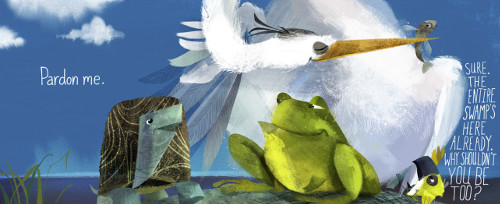


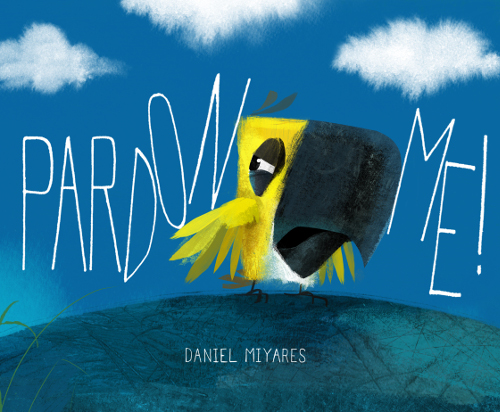
Click here to see early sketches and development work from the book
(Click each to enlarge)
Daniel: I use inks, watercolors, gouache, acrylics, and digital tools to build my images.
Jules: If you have illustrated for various age ranges (such as, both picture books and early reader books OR, say, picture books and chapter books), can you briefly discuss the differences, if any, in illustrating for one age group to another?

Daniel: I’ve gotten to try a variety of book-type projects. I’ve made picture books, did a novel cover, and when I was first starting out I got to illustrate some serial books for the Kansas City Star newspaper. No matter who the book audience is, I try to use the same approach to visual storytelling. The principles of design and timing speak to all age groups, I think. I have learned, however, that young children have an easier time appreciating where a story wants to take them. Something about getting older dulls our ability to imagine and tolerate the absurd. I’ve found that in the picture books I make I can paint what something feels like and not just what it looks like. Sometimes to tell a proper story you need the freedom to break with truth and reality. Kids get that in a big way.
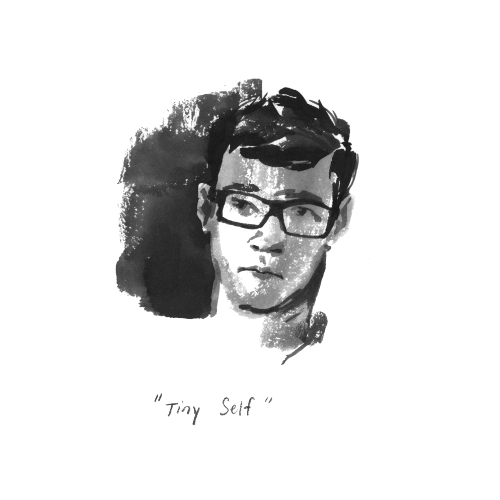
Jules: Where are your stompin’ grounds?
Daniel: I live in the middle of the map as they say, the city of Overland Park, Kansas. It’s just south of Kansas City.

Jules: Can you briefly tell me about your road to publication?
Daniel: My first book gig was a collaboration with Singer/Songwriter Neil Sedaka. He was working with Imagine Publishing to bring some re-works of his hit songs to life as picture books. The first one they wanted to do was Waking Up Is Hard To Do [pictured below]. It was 2009. I had just finished building a portfolio with my artist rep (Studio Goodwin Sturges), when they said there may be an opportunity for me, but … you would need to do a sample piece for the story on spec. It wasn’t like I had another project going on at the time, so I said sure. I’m assuming they had a handful of other artists contending for the book as well. We went a few rounds on the samples to define my take on the story, and in the end I got to do the book. For a young illustrator, it was like jumping off the end of the pier to learn how to swim. The stakes felt high. The deadlines were tight. I learned so much about who I was as a book maker, as well as who I might want to be going forward. Also, I realized just how amazing of a creative family I had in my Studio Goodwin Sturges partners. They really gave me an education on the nuts and bolts of bookmaking.
Neil was a force. I really admire his passion for music and passing that on to his grandchildren. You could tell he was totally smitten by them. Before I knew it he was on the Today show talking about our book with Kathie Lee and Hoda.

It was a wild first adventure as a book illustrator. Pretty soon after that, I started to feel the pull to tell my own stories.
Jules: Can you please point readers to your web site and/or blog?
Daniel: danielmiyares.comm or on Instagram @danielmiyaresdoodles — and on Twitter @danielmiyares.

Jules: If you do school visits, tell me what they’re like.
Daniel: I try to tailor my presentations to the audiences.
If it’s a large school-assembly kind of situation, I’ll do a slide show and discussion that starts with when I knew I wanted to be an artist (at about age four).
I also like to share what I think an Author/Illustrator really does. No matter what the age group is, if I ask what an Author/Illustrator does, I get the same answer: “They write the words and draw the pictures.” Technically, they’re right, but I’m convinced there’s a lot more fun and adventure in it than that. To prove it, I share an example of a three sentence story that I wrote for a children’s book class I taught a while back at the Kansas City Art Institute. First I share it with just the words and I ask if it’s a good story. Usually I get a resounding NO! Sometimes I get a boo or two. (Kid-honesty is the best.)

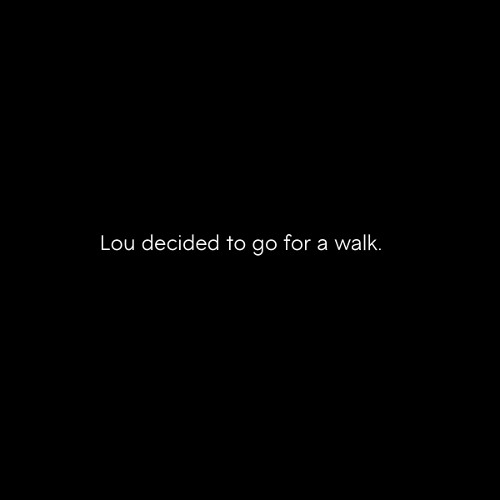

Next, I share the same story again, except I’ve added some rough sketches to it. This time I usually get belly laughs and cheers. Really I just want to share that words and pictures don’t have to be serious, intimidating business. Telling stories can be a lot of fun.


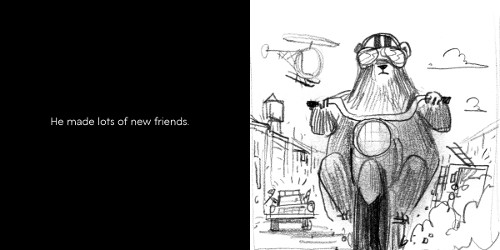
I also do readings of my books. The kids are usually so respectful and well-mannered. I invite them to take part in the readings. They help me figure out what’s going to happen next or shout out questions or suggestions. I’ve learned so much about my books through those interactions. Secretly, my goal is to get them whipped up over a story. I want the students to have as much joy and excitement as possible around the reading experience.
My finale is usually a live drawing demo. I make the wild claim to the crowd that it’s possible to make any animal in the world out of basic shapes. Mostly they don’t believe me, so I ask for a shape suggestion from the audience. I draw that on the pad of paper. Then I ask for the animal. If all works out, we end up with some pretty fun stylized animal drawings. As time allows, I’ll get some other brave souls up there to convert shapes into animals, too.
For smaller groups (like the size of one classroom), I’ll change it up to be more hands-on. I like having an activity where we make something together. If they’re on the older side, I break out the three-sentence story assignment for them. It’s a lot of fun, plus I like leaving things behind that they can keep working on or do again in their own way with their teachers.








Jules: If you teach illustration, by chance, tell me how that influences your work as an illustrator.
Daniel: When I’ve had the opportunity to teach classes, I’m always amazed at how much I grow personally. There’s something about taking on the responsibility of helping others connect dots that inevitably leads to my own dot-connecting.
I was teaching a children’s book class at the same time I was working on Float. When we covered basic principles, like pacing and composition, I would bring in-progress art from my book to speak to. They enjoyed talking about real world examples, and I got some straightforward feedback on how things read. There’s a wonderful accountability that goes along with being transparent.
Also, the student’s passion and curiosity for art and design is infectious. It’s really hard to replicate that energy outside of a classroom.

(Click to enlarge)
Jules: Any new titles/projects you might be working on now that you can tell me about?
Daniel: I just wrapped up the art on my next book with Simon & Schuster. It’s called Bring Me A Rock! It will be released Summer of 2016. It’s about a megalomaniac insect king on a power trip and the little bug who saves the day.
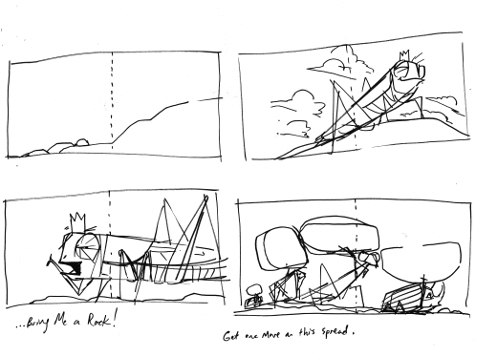

(Click each to enlarge)
Also, I am in the middle of illustrating a new book that Kwame Alexander wrote for North South, called Surf’s Up.

 Okay, we’ve got our tea (despite the contrarian coffee cup pictured here), and it’s time to get a bit more detailed with seven questions over breakfast. I thank Daniel again for visiting 7-Imp.
Okay, we’ve got our tea (despite the contrarian coffee cup pictured here), and it’s time to get a bit more detailed with seven questions over breakfast. I thank Daniel again for visiting 7-Imp.
1. Jules: What exactly is your process when you are illustrating a book? You can start wherever you’d like when answering: getting initial ideas, starting to illustrate, or even what it’s like under deadline, etc. Do you outline a great deal of the book before you illustrate or just let your muse lead you on and see where you end up?
Daniel: In describing my process, I have to mention Uri Shulevitz’s book Writing With Pictures. A friend turned me onto it when I was building my first book concepts as an author/illustrator. In the second paragraph of the first chapter, Uri says, “A picture book says in words only what pictures cannot show.”
This simple idea helped the tumblers fall into place for me. Don’t let your words try and do what your pictures are doing and vice versa. The magic for me is that space in between word and image. Now when I’m working on a book idea, I do rough loose thumbnail drawings and write at the same time. I also like drawing and writing quickly so nothing is too precious in early stages.


(Click final art to enlarge)


(Click final art to enlarge)
My ideas for stories come from all over the place. I wish I had a clean formula for generating a great idea. As best as I can tell, I usually start with a personal struggle or anxiety. I know that doesn’t sound very uplifting, but I believe that if you can show real human struggle and how it’s overcome or redeemed, people will connect to it.
Float was a different one for me. I didn’t start with an idea at all. I was flying home from my aunt’s funeral, and on the plane I did a small drawing of a boy floating a paper boat in a puddle. As I looked at it I wondered what happened just before that moment — and I drew it. Then I wondered what happened after and I drew that. I went on like this until I found the beginning and end of the story. It felt like carving something out of stone. The plot line was in there already; I just needed to knock off what didn’t belong to uncover it.


(Click final art to enlarge)


(Click final art to enlarge)


(Click final art to enlarge)
When it comes to making art, I usually always make a quick rough sketch to start from. I try not to overdraw my sketches. Many times I’ve fallen in love with a drawing that says it all and then proceeded to choke the life out of a finished painting of it. Now I try to let my sketches give me the energy and spirit I want in my finished piece but not take it too far. I think I have the best outcomes and the most fun when I make some discoveries in my finished paintings.
I use a variety of media. I use inks, watercolors, gouache, acrylics, and digital tools. I paint the elements for my pieces separately and compile them digitally. It allows me to focus on mark-making, edges, and surface texture in a free way. So, for instance, in Float I painted most of the backgrounds with inks and watercolors wet into wet. I wanted it to feel rain-soaked throughout, but for the little boy I cut shapes out of some of my hand-painted textures on the computer. You know how rain slickers are kind of stiff and have those harsh distinct creases in them? It seemed like a fun contrast to those deep, washy, rolling neutral greys.


(Click final art to enlarge)


(Click final art to enlarge)
Aside from the hours upon hours holed up in my studio drawing and painting, making books for me has to be a team sport. The collaborations with my reps, editors, and design partners have truly helped to make my books the best they can be. I hope I never feel like I’ve got it all figured out.
2. Jules: Describe your studio or usual work space.
Daniel: My workspace now is a studio/office in the lower level of my house. We moved in not too long ago, and I’m thrilled to have a separate room set aside to make stuff in. Up until now, our finished attic doubled as our bedroom and studio. My wife is some kind of saint for putting up with all those late nights.
I like painting on this old reclaimed library table a friend of mine gave me when I first moved to Kansas City many years ago. Painting flat suits my love of wet media. Since I use digital tools, too, I like to be just a chair-swivel away from my Mac.

I have realized that when I’m cooking up ideas for stories and concepting new projects, being out and about works well for me. I spend lots of time in coffee shops and libraries with my sketchbooks.

(Click to enlarge)
3. Jules: As a book-lover, it interests me: What books or authors and/or illustrators influenced you as an early reader?
Daniel: Shel Silverstein really ignited my imagination as a kid. In the third grade, I had a teacher read to us from A Light In the Attic. I couldn’t believe we were allowed to read things like that in school. It seemed unfair, like we were getting to skip our school lessons.
Later on, it was Mark Twain’s short stories that got me. And poetry — Langston Hughes, E.E. Cummings, and the imagist poets. I quickly saw that language could evoke the most visceral of feelings.



(Charlesbridge Publishing, 2012)
(Click spreads to enlarge)
4. Jules: If you could have three (living) authors or illustrators—whom you have not yet met—over for coffee or a glass of rich, red wine, whom would you choose? (Some people cheat and list deceased authors/illustrators. I won’t tell.)
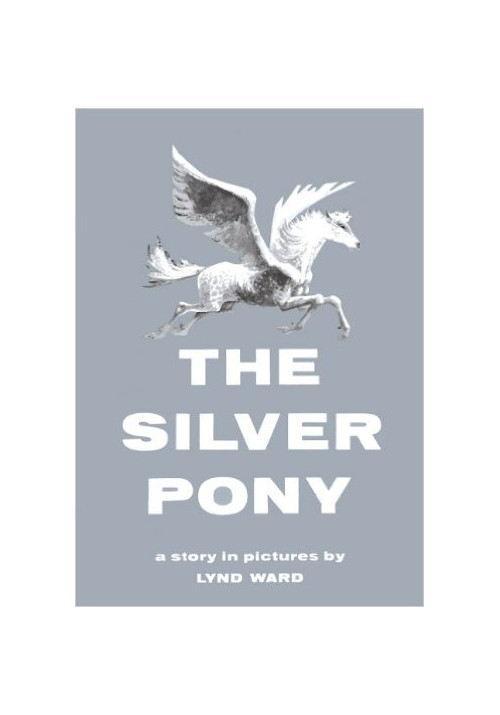

Daniel: Ok, as long as it’s between us. Let’s see … I might have to do both living and non.
William Joyce — I’d love to throw around book ideas with him. I don’t know him at all, but he seems like a great idea man.
Alice and Martin Provensen — I’m rather intrigued with how the collaboration worked, but really because The Glorious Flight is one of my all time faves.
Lynd Ward — Because his drawings are ridiculous! Maybe we could’ve drawn together. A friend pointed me toward The Silver Pony, and I can’t stop going back to it.

5. Jules: What is currently in rotation on your iPod or loaded in your CD player? Do you listen to music while you create books?
Daniel: I do listen to tunes when I work. Currently I’ve got Dave Brubeck, R.E.M., Sam Cooke, The Cure, Spoon, Dr. Dog. …
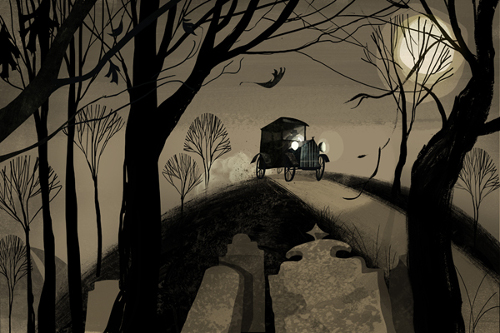
6. Jules: What’s one thing that most people don’t know about you?
Daniel: I’m a huge John Cusack fan. Whenever he does a new movie—good, bad, or horrible—I have to see it.

and made me a plush paper boat.”
7. Jules: Is there something you wish interviewers would ask you — but never do? Feel free to ask and respond here.
Daniel: I usually don’t get asked about my family, but they’re so much a part of what I do. My wife and I [pictured below] have a six-year-old daughter, named Stella, and a three-year-old son, named Sam. I didn’t grow up dreaming about making picture books. After my daughter was born, it started to make a lot of sense to me. Seeing the world through my children’s eyes has been a real privilege. I never expected they would have such an impact on my creative pursuits. Plus, they constantly remind me of what’s important in life. If left to my own devices, I worry I would be all work and no play. They keep me in a healthy balance.
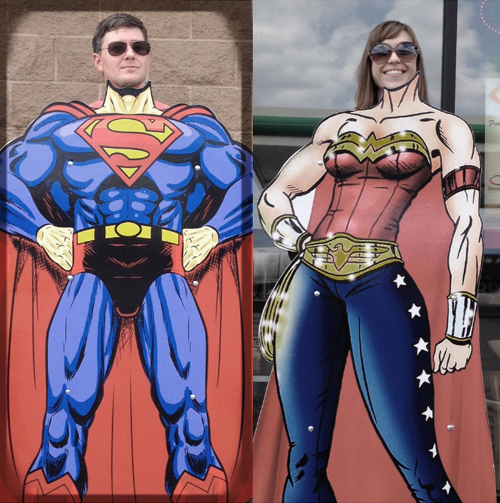

Jules: What is your favorite word?
Daniel: “Quietude.”
Jules: What is your least favorite word?
Daniel: “BOGO” (not the deal, just the acronym).
Jules: What turns you on creatively, spiritually or emotionally?
Daniel: Good art, films, poetry, the fam, drawing just because, down time.
Jules: What turns you off?
Daniel: Doing the same things over and over and small-mindedness.
Jules: What is your favorite curse word? (optional)
Daniel: Does “poop” count? In my house, it counts.
Jules: What sound or noise do you love?
Daniel: Belly laughs.
Jules: What sound or noise do you hate?
Daniel: Silent cries. (You know, those out-of-breath kid-cries, where it takes the sound a minute to catch up to the face.)
Jules: What profession other than your own would you like to attempt?
Daniel: Teacher.
Jules: What profession would you not like to do?
Daniel: Accountant. (No offense. It just ain’t me.)
Jules: If Heaven exists, what would you like to hear God say when you arrive at the Pearly Gates?
Daniel: “Welcome.”
All images are used by permission of Daniel Miyares.
The spiffy and slightly sinister gentleman introducing the Pivot Questionnaire is Alfred, copyright © 2009 Matt Phelan.

Fantastic. Useful. In-depth interview. Thank you! Love Daniel’s style! Love the cover, the translucence of Float! Brilliant way to interact with kids.
Love the words without the pictures exercise. As an
author, it really has me thinking. Such talent. Love Float and Pardon Me. Thank you so much for this insightful interview.
LOVE the idea for the school presentation. Such a great surprise for the audience. Anticipation and leaving them with something to think about after you’re gone seems like a great plan. I’ve taught for many years and am now tired. I think the good solution would be to do it part time if you can 🙂 Great balance that way.